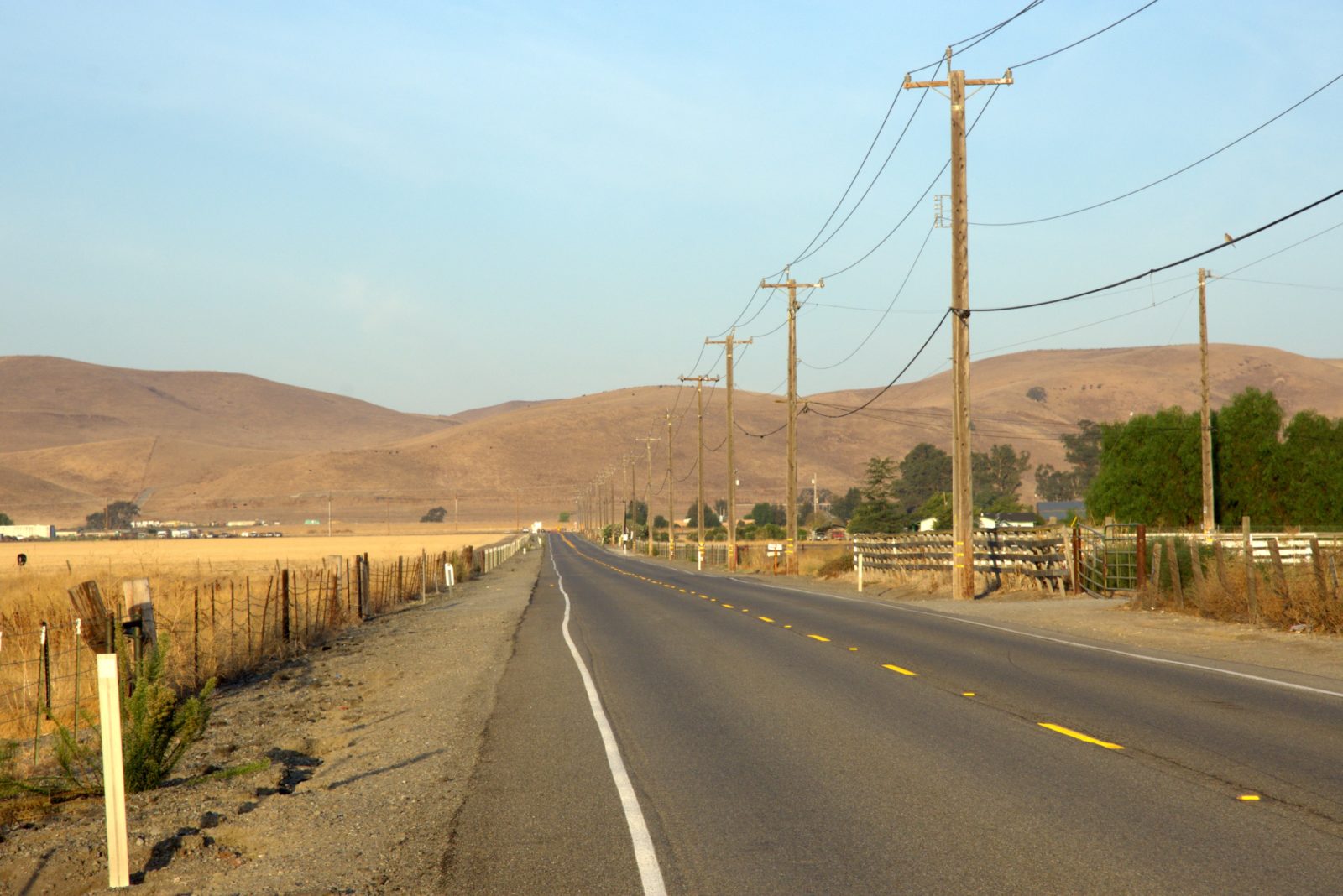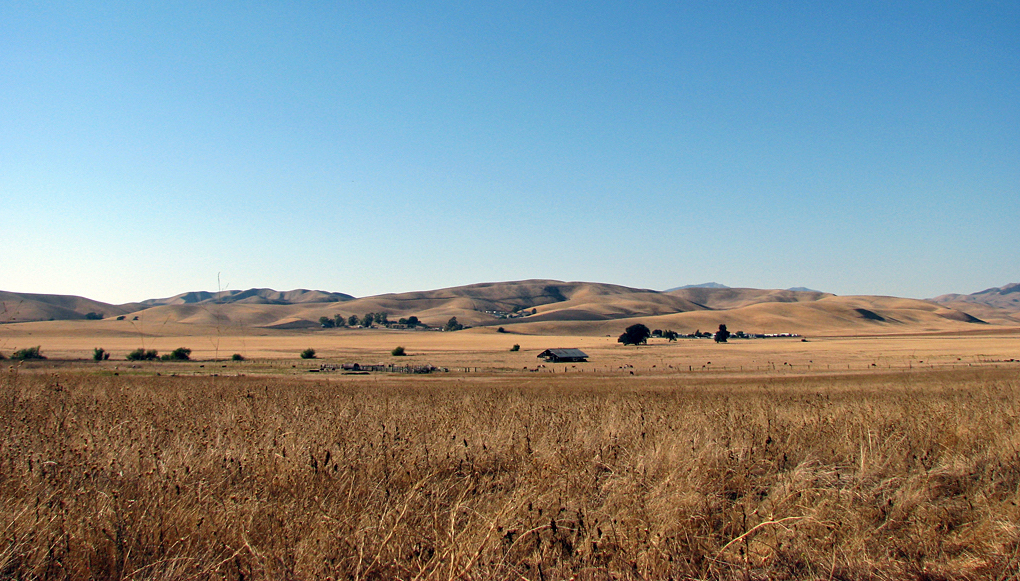Looking at the North Livermore Valley, it’s easy to forget that three of California’s largest cities lie less than an hour’s drive away. In late winter and early spring, the rural valley’s open pastures, cradled by rolling hills and dotted with oaks, flush green with new growth, and the ephemeral Cayetano Creek springs to life. The nutrient-poor soil can’t support much more than cattle grazing and cattle feed production, and by late spring, the grasslands have turned brown. Raptors soar overhead, scanning the landscape for prey, while cows nibble on the non-native grasses that dominate the landscape.
To some, the North Livermore Valley is a pastoral slice of East Bay rural tradition that residents have fought to protect from development for decades. To others, it’s low-quality agricultural land that would be put to better use for meeting the Bay Area’s bigger goals.
These two competing visions for the future of the North Livermore Valley are at the heart of the debate over the Aramis Renewable Energy Project, a 347-acre solar facility that was approved by the Alameda County Board of Supervisors in March. The project, which will be the Bay Area’s largest solar facility, will provide 100 megawatts (MW) maximum capacity of solar energy and another 100 MW of four-hour storage, providing enough clean energy to power 25,000 homes annually.
The development is part of California’s effort to achieve 100 percent clean energy by 2045, a goal established in 2018 by the California 100 Percent Clean Energy Act. The state met its 33 percent renewable energy target for 2020 well ahead of schedule and is on track to get 60 percent of retail electricity sales from renewable energy sources by 2030. In fact, on April 24, 2021, California’s main energy grid was powered by almost 95 percent renewable energy—even if it was just for four seconds.
But according to a state report released in March 2021, California will have to increase its renewable energy deployment to “record setting” levels—perhaps triple the rate of the previous decade—to reach 100 percent by 2045. Achieving this goal will likely require converting more and more of California’s undeveloped lands into seas of solar panels.
“We have a real strong need in the state to deploy as much renewable energy as quickly as we can,” says Ethan Elkind, the director of the Climate Program at UC Berkeley’s Center for Law, Energy, & the Environment. But, he says, “That doesn’t mean we should be reckless about it, or put it in places where we might be sacrificing other values needlessly.”
Among the North Livermore Valley solar project’s proponents are the Sierra Club, the Natural Resources Defense Council, the National Audubon Society, California Audubon, Mount Diablo Audubon Society, several local politicians, and a number of workers’ unions. Supporters of the project say that in addition to providing much-needed clean energy and storage to help slow climate change, the project will increase local energy reliability, help displace nearby fossil fuel power plants that pollute frontline communities, and provide 400 local jobs and millions of dollars in local investment and tax revenue.
Opponents, however, argue that North Livermore Valley, where the project will be located, is not the place for a utility-scale solar facility. Environmental groups such as the Ohlone Audubon Society, Golden Gate Audubon Society, and Save Mount Diablo have been critical of the project’s possible impacts on threatened or endangered species. A group called Save North Livermore Valley, as well as Friends of Open Space and Vineyards and Ohlone Audubon Society, allege that Alameda County’s approval of the development violates local laws that protect the agricultural heritage and scenic beauty of the valley, as well as the California Environmental Quality Act. On April 20, the three groups filed a lawsuit against the county.
According to a report released earlier this year from Columbia Law School’s Sabin Center for Climate Change Law, local opposition to renewable energy projects is widespread. The report lists over 150 renewable energy projects around the country that have been stalled, reduced, or denied permits due to opposition from local communities for reasons ranging from Indigenous land rights to “not in my backyard” attitudes to environmental concerns, demonstrating the significant power that local communities and governments have in negotiating the tradeoffs between open space and renewable energy.
Elkind says that opposition from neighbors, which has killed dozens of climate-smart housing density projects in the Bay Area, is a huge obstacle for renewable energy projects as well. “Nobody’s gonna say that all of our clean energy goals will fall apart just based on one project, but you look at the cumulative effect of that logic, and it becomes harder to get where we need to go,” he says. “We want public participation, and you want to know what the impacts are and mitigate them where possible, but it should not be about stopping a project unless it’s in violation of the law in some way.”
The Sierra Club, which supports the project, has been on both sides of such “green vs. green” fights. As a proponent of both open space conservation and renewable energy, “we look at these issues really carefully,” says Luis Amezcua, a senior campaign representative with the Sierra Club. “We do want to build all the clean energy that we need, but we also have to be mindful of where we put it.”
A few years ago, the Sierra Club and other environmental groups opposed a solar project on ranchlands in the remote Panoche Valley about 100 miles southeast of Livermore, arguing that the site was critical habitat for numerous listed species. After years of litigation, the developer agreed to reduce the project to around one-third of its original size and permanently protect 26,000 acres of land in and around the Panoche Valley in order to compensate for the negative ecological impacts of the project. Amezcua said the Sierra Club uses an internal process to evaluate clean energy projects on a case by case basis, which may explain why they opposed the Panoche Valley project but support the Aramis project. “We take it very seriously because it’s something that our members really care about,” he says.
Privately owned, low-quality agricultural land, such as that of North Livermore Valley, Amezcua says, is “prime space” for renewable energy facilities, in part because it provides low-income farmers an opportunity to sell or lease agriculturally unprofitable land. In a letter of support submitted to the Alameda County Board of Supervisors, Amezcua wrote that the Aramis facility will actually help improve the landscape of the North Livermore Valley and boost its habitat value by eliminating pesticides, planting native plants, and discontinuing annual discing.
The Environmental Impact Report (EIR) process was “pretty robust,” says Amezcua, and after careful review, the Sierra Club agreed that the project will not result in any significant negative environmental impacts, aside from aesthetic impacts, that can’t be mitigated on what they see as an already degraded landscape. “You can go there yourself and you can see that it is planted with non-native grasses,” he says. “A lot of the biological species that [project opponents] are worried about are no longer there because of that heavy cattle grazing and discing that was happening for more than a century.”
Letters submitted to the Alameda County Planning Department from the U.S. Fish and Wildlife Service and California Department of Fish and Wildlife, however, argue that the draft Environmental Impact Report for the project underrepresented its negative impacts on wildlife. The agencies criticized the biological surveys and/or mitigation measures for various listed species, including the threatened Central California tiger salamander, California red-legged frog, San Joaquin kit fox, burrowing owl, and golden eagle. EBRPD biologist Doug Bell also noted the need for a more comprehensive avian and bat mortality monitoring plan. The USFWS and CDFW concluded that because the project would likely harm listed species, Intersect Power should apply for incidental take permits. The three agencies also advocated for compensatory mitigation measures, such as preserving additional acreage for habitat conservation, for negative impacts that can’t be avoided.
Seth Adams, the conservation director at Save Mount Diablo, which has been critical of the project, says it’s “bullshit” when solar developers “come in and try to act like their project is benign.” He says that even after construction is finished, the project will provide almost no habitat for local wildlife. “It’s gonna take a piece of upland habitat which is grassland and convert it to a different use,” Adams says. “There are gonna be trucks, and people, and effects on all kinds of different things. This is not a solar panel in a field, it’s an industrial energy facility.”

Intersect Power has reiterated that no protected species were found at the project site and contends that the EIR is both legal and accurate. However, in response to the USFWS and CDFW’s concerns, the company is pursuing incidental take permits for the listed species as well as a conservation easement for the perpetual protection and management of a separate property. Khristyn Brimmeier, a spokesperson for Intersect Power, wrote in an email that the proposed property, approximately the size of the Aramis project footprint and located in east Alameda County south of Interstate 580, consists of critical habitat for the California red-legged frog and California tiger salamander, as well as high-quality habitat for golden eagles and other species. She said a habitat conservation plan will be made public once the USFWS begins its review.
Other mitigation measures stipulated in the final EIR include extensive monitoring for birds and protected species, various efforts to limit and discourage protected species from entering the project area during construction, and avoidance of these species if they are detected. The project will also be set back a minimum of 50 feet from the sensitive riparian habitat of Cayetano Creek, which is designated as an “essential” conservation priority by the Conservation Lands Network.
TriValley Conservancy, a Livermore-based land trust that has not taken a position for or against the project, has agreed to work with Intersect to ensure that all the agreed-upon monitoring and mitigation measures are taken before and during construction and through the life of the project. “We wanted to make sure that we gave the community as much comfort as possible that we’re doing what we said we’re gonna do,” says Marisa Mitchell, head of environmental and permitting at Intersect Power.
Following a request from the county, the project will incorporate agricultural components, including sheep grazing, an apiary, and egg-laying hens who will fertilize and feed on the vegetation between the arrays, Mitchell says. Intersect also plans to open some of the land up to the public with a trail along Cayetano Creek, which EBRPD Chief of Planning Brian Holt suggested could connect to the district’s San Francisco Bay to San Joaquin River Regional Trail. Mitchell says that neighbors’ concerns have mostly been related to aesthetics, and in response, the project will use an agricultural style fence for the project and thick vegetation to try to shield the arrays from view. “I’ve had lots of conversation with folks … and I think we’ve done our absolute best to address every single one of the concerns we’ve heard,” she says. “The one concern that we cannot really accommodate is: don’t build the project.”
Save North Livermore Valley attorney Rob Selna says he believes a utility-scale renewable energy facility is “a violation of voter intent” of Measure D, a ballot initiative passed in 2000 to limit suburban sprawl and protect agriculture in the rural eastern part of Alameda County. It also goes against the county’s General Plan, he says, which designated the area as a Scenic Rural Recreational Route and protects it from the project’s “significant and unavoidable adverse impact” on the scenic value and aesthetic resources of the valley.
Selna says it’s an oversimplification to say the battle is about Save North Livermore Valley’s opposition to clean energy or a NIMBY attitude. “The reality is it’s a conflict that is inherent in the expansion of clean energy and reaching California’s goals, and the only way to do it and satisfy all of California’s environmental goals is to plan well and thoughtfully,” he says.
If proponents and opponents of the Aramis project agree on one thing, it’s that Alameda County needs a comprehensive plan for utility-scale solar projects. Many point to “least-conflict” mapping done in the San Joaquin Valley, which brought together various stakeholders, including conservationists, agricultural interests, government agencies, tribes, and solar PV development industry members, to find suitable sites for renewable energy development in the area. Elkind, who was a primary author on the San Joaquin Valley least-conflict mapping report, says, “Every county in California should have some kind of process to figure out the best lands for deploying these kinds of large scale facilities.”
Advance planning helps to minimize conflict for individual renewable energy projects, Elkind says, and when projects are less contested, they are significantly faster and cheaper to complete. Alameda County, however, hasn’t yet finalized a solar policy or completed least-conflict mapping for local renewable energy projects.
It’s “a pretty significant failure of government on Alameda County’s part,” Selna says. The county started planning work nine years ago, but never finished, he says, even as neighboring counties completed their policies. “Basically, if you want to cut to the chase,” he says, “they dropped the ball.”
Shawn Wilson, the chief of staff for Alameda County Supervisor David Haubert, who represents the North Livermore Valley, says that their initial attempt to develop a solar policy was “a long unproductive process” due to disagreement within the community about the development of agricultural lands. After that, he says, the supervisors began considering projects on a case by case basis and the longer-term project of developing a solar policy fell by the wayside. “We did direct staff to come up with a solar policy, but no one was pressing them to do so because we didn’t have any projects in the pipeline,” he says.
Wilson said that county staff do intend to finalize a solar policy, but said he’s not sure about the status of a solar mapping project. “It’s an exercise in futility, when you think about it. You don’t need a mapping exercise to tell you where a solar project could land,” he says, because only three areas under county jurisdiction can connect to the electrical grid with existing infrastructure. “It’s really just a few areas, and North Livermore happened to be one area where they’re close to a substation.”

Building new transmission lines to areas that might otherwise be good potential locations is often a financial non-starter with developers, says Elkind, not to mention the additional environmental impacts and added time needed to finance, permit, and build out that infrastructure. “Transmission availability really does drive these siting decisions,” he says.
Distributed solar systems, like rooftop panels, skirt these complex issues of developing transmission lines and swallowing open space, and currently, they provide almost half of the state’s solar capacity. But, Elkind says, “We need both. We do need distributed solar. But we also need large-scale facilities,” because economies of scale make the large facilities much cheaper and faster to build.
Despite his deep concerns about habitat conversion and ecological impacts, Adams says he’s optimistic about the rollout of renewable energy. “We’re gonna spend trillions of dollars to convert our energy system into one that doesn’t generate carbon and that’s necessary, but it’s also got lots and lots of issues that are related to it,” he says. He predicts a gold rush for land and “a tidal wave of investment” for renewable energy facilities in the coming years, which will be either incredibly disruptive or less so, depending on where, how, and under what conditions the projects are deployed.
“It’s gonna be tedious and time-consuming and involved both at the project level and at the policy level, but we’re gonna do a better job in the Bay Area than practically anywhere else in the United States because more people will be involved,” he says.“Just having us show up at meetings and push for better policies will get better outcomes.”





